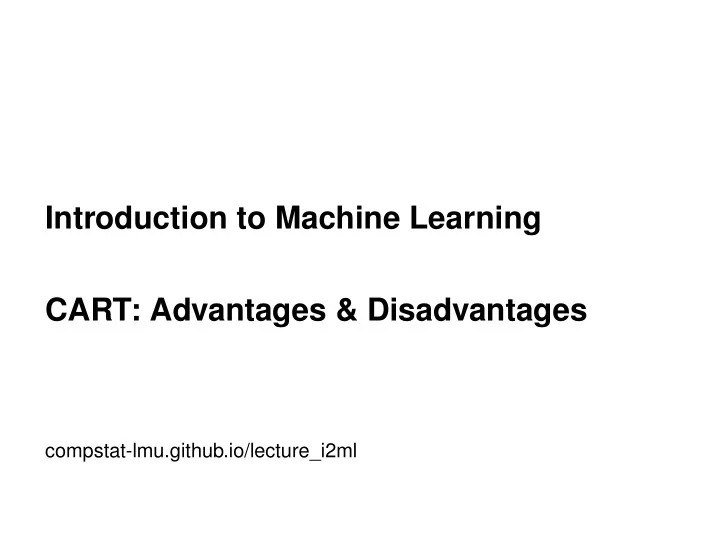

Introduction to Machine Learning CART: Advantages & Disadvantages compstat-lmu.github.io/lecture_i2ml
ADVANTAGES Fairly easy to understand, interpret and visualize. Not much preprocessing required: automatic handling of non-numeric features automatic handling of missing values via surrogate splits no problems with outliers in features monotone transformations of features change nothing so scaling of features is irrelevant Interaction effects between features are easily possible, even of higher orders Can model discontinuities and non-linearities (but see "disadvantages") � c Introduction to Machine Learning – 1 / 7
ADVANTAGES Performs automatic feature selection Quite fast, scales well with larger data Flexibility through definition of custom split criteria or leaf-node prediction rules: clustering trees, semi-supervised trees, density estimation, etc. � c Introduction to Machine Learning – 2 / 7
DISADVANTAGE: LINEAR DEPENDENCIES 1.00 ● ● ● ● ● ● ● ● ● ● ● ● ● ● ● ● ● ● 0.75 ● ● ● ● ● ● ● ● ● ● ● ● ● ● ● y ● ● ● x2 0.50 ● ● 0 ● ● ● ● 1 ● ● ● ● ● 0.25 ● ● ● 0.00 0.00 0.25 0.50 0.75 1.00 x1 Linear dependencies must be modeled over several splits. Logistic regression would model this easily. � c Introduction to Machine Learning – 3 / 7
DISADVANTAGE: SMOOTH FUNCTIONS 1.0 ● 0.5 ● y 0.0 ● ● ● ● −0.5 ● 0.2 0.4 0.6 0.8 1.0 x Prediction functions of trees are never smooth as they are always step functions. � c Introduction to Machine Learning – 4 / 7
DISADVANTAGES Empirically not the best predictor: Combine with bagging (forest) or boosting! High instability (variance) of the trees. Small changes in the training data can lead to completely different trees. This leads to reduced trust in interpretation and is a reason why prediction error of trees is usually not best. In regression: Trees define piecewise constant functions, so trees often do not extrapolate well. � c Introduction to Machine Learning – 5 / 7
FURTHER TREE METHODOLOGIES AID (Sonquist and Morgan, 1964) CHAID (Kass, 1980) CART (Breiman et al., 1984) C4.5 (Quinlan, 1993) Unbiased Recursive Partitioning (Hothorn et al., 2006) � c Introduction to Machine Learning – 6 / 7
CART: SYNOPSIS Hypothesis Space: CART models are step functions over a rectangular partition of X . Their maximal complexity is controlled by the stopping criteria and the pruning method. Risk: Trees can use any kind of loss function for regression or classification. Optimization: Exhaustive search over all possible splits in each node to minimize the empirical risk in the child nodes. Most literature on CARTs based on “impurity reduction”, which is mathematically equivalent to empirical risk minimization: Gini impurity ∼ = Brier Score loss, entropy impurity ∼ = Bernoulli loss, variance impurity ∼ = L2 loss. � c Introduction to Machine Learning – 7 / 7
Recommend
More recommend